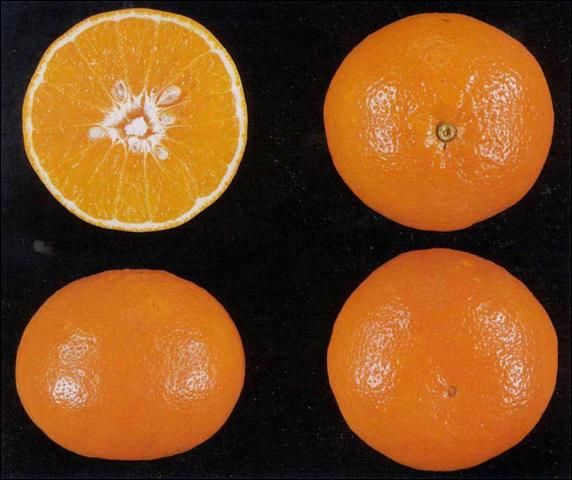Orlando Tangelo
The Orlando tangelo (Figure 1) is a cross between Dancy tangerine and a Duncan grapefruit which was made by W. T. Swingle of the U.S.D.A. in 1911. Originally this variety was known as "Lake tangelo" but changed to "Orlando" many years ago.

Credit: UF/IFAS CREC
Fruit Characteristics
The size and shape are tangerine-like with an average diameter of 2¾ - 3 inches, with the color and texture more closely the color of an orange. Seed number will vary depending on cross-pollination from a low of zero seeds in solid blocks to as many as 35 per fruit in blocks of high cross-pollination. The rind adheres firmly to the pulp and is not easily peeled by hand. Since this variety produces poorly in solid set blocks, it is recommended that cross-pollination be used to enhance yields.
Commercial harvest season is from November through January.
Tree Characteristics
The trees will grow to a large size and the foliage is easily recognized by the characteristic cup-shaped leaves. This variety is recognized as being one of the more cold tolerant varieties.
Cultivation
This variety has been quite popular over the years and has been used frequently as a pollenizer for many of the citrus hybrids. In recent years, demand for the fruit has decreased making it difficult to sell.
-
Since Orlando is self-incompatible, it produces poorly in solid blocks and should be planted in conjunction with other suitable varieties to enhance yields. Suitable pollenizers would include Temple as very good with Sunburst and Osceola being good.
-
In groves which have experienced poor fruit set, the use of the growth regulator gibberellic acid (GA), has increased fruit set and yield when sprayed at full bloom.
-
Annual tree girdling was used in the 1960s as a method to increase yields but was discontinued due to cost. This offers a method of increasing fruit set and yields on young, vigorous trees of Orlando.
-
Orlando tangelos have been observed to use higher rates of nitrogen than many of the sweet orange varieties. In the fall and winter, yellow leaves are frequently observed and in many cases high leaf loss will occur due to this nitrogen deficiency which is commonly referred to as winter chlorosis. It is generally recommended that higher rates ranging from 200 to 300 pounds of nitrogen per year be applied. The total yearly amount should be divided into at least three or more applications.
-
Alternaria brown spot fungal disease has been known to attack Orlando tangelo when planted in or near blocks which are highly susceptible to Alternaria. Alternaria in these blocks can cause not only fruit damage and drop but also damage foliage as growth flushes emerge.
-
Cleopatra mandarin rootstock has been the most common rootstock used over the years. Other rootstocks such as Carrizo and Swingle can also be used.
More Information
2020–2021 Florida Citrus Production Guide: Alternaria Brown Spot, CG021.
Futch, S.H. and L.K. Jackson, 2021, Cross-Pollination Planting Plans, UF IFAS HS170.
Futch, S.H. and L.K. Jackson, 2021, Pollination of Citrus Hybrids, UF IFAS HS182.
Krezdorn, A.H. 1981. "Fruit Set of Citrus." Proc. Int. Soc. Citriculture. 1981:249-253.
Krezdorn, A.H. 1977. "Influence of Rootstock on Mandarin Cultivars." Proc. Int. Soc. Citriculture. Vol. 2. p. 513-518.
Krezdorn, A.H. and W.J. Wiltbank. 1968. "Annual Girdling of 'Orlando' Tangelos over an Eight-Year Period." Proc. Fla. State Hort. Soc. Vol. 81:29-35.
Saunt, James. 2000. Citrus Varieties of the World. Sinclair International Limited, Norwich, England. p. 82.
Tucker, D.P.H., A.K. Alva, L.K. Jackson, and T.A. Wheaton. 1995. Nutrition of Florida Citrus Trees. SP-169. University of Florida, Institute of Food and Agricultural Sciences, Cooperative Extension Service. p. 27.
Whiteside, J. O. 1979. "Alternaria Brown Spot of Dancy Tangerine and its Control." Proc. Fla. State Hort. Soc. 92:34-37.


